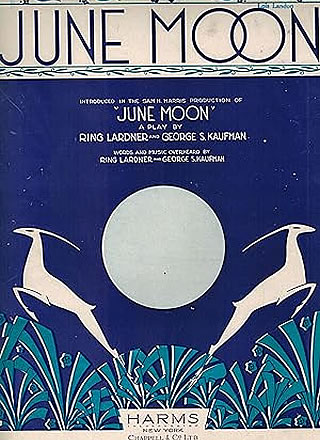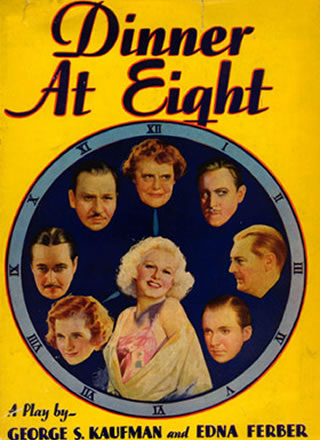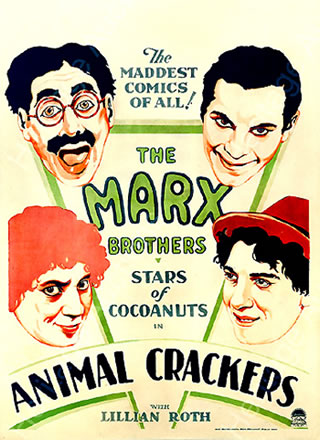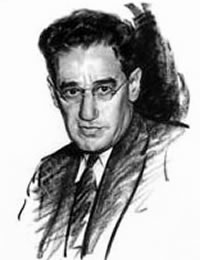Once In A Lifetime
(1930)
By Moss Hart and George S. Kaufman
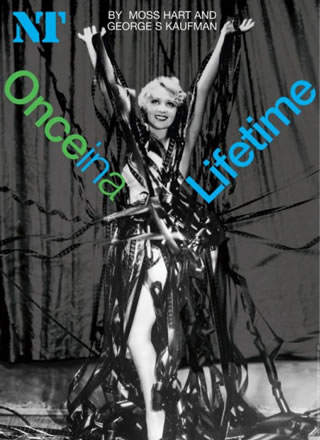
Cast size: 20 men, 19 women, plus extras; 5 sets
There had been very few plays about Hollywood—and even fewer satires—when the 24-year-old Moss Hart approached George S. Kaufman in 1929 with a first draft called Once in a Lifetime. Kaufman leapt at the chance to collaborate with the first-time writer and, although neither man had been to Hollywood, they had been inundated with enough fatuous material in the press and with enough dopey movies to take a crack at satirizing the film colony.
For performance rights, contact: Concord Theatricals
For performance rights to a reduced cast version, contact: patrick.herold@unitedtalent.com

Table of Contents
The Plot
 It’s winter of 1928 and the biggest news in entertainment is the whopping success of Al Jolson in The Jazz Singer, the first all-talking picture. A down-at-heels vaudeville troupe—the ascerbic May Daniels, the fast-talking Jerry Hyland, and their slightly dopey cohort, George Lewis, the “best deadpan feeder in the business—decide to make their fortune by going Hollywood. The only problem is: they don’t know what they’re going to do out there. That’s all right: no one knows anything in Hollywood either.
It’s winter of 1928 and the biggest news in entertainment is the whopping success of Al Jolson in The Jazz Singer, the first all-talking picture. A down-at-heels vaudeville troupe—the ascerbic May Daniels, the fast-talking Jerry Hyland, and their slightly dopey cohort, George Lewis, the “best deadpan feeder in the business—decide to make their fortune by going Hollywood. The only problem is: they don’t know what they’re going to do out there. That’s all right: no one knows anything in Hollywood either.
The trio pretends to be a team of skilled vocal coaches and, with the help of Lotusland’s greatest gossip columnist, Helen Hobart, they find themselves working for Herman Glogauer, the volatile producer behind Glogauer Pictures. Glogauer doesn’t know what to do about his actors in talkies:
“Things were going along fine. You couldn’t stop making money—even if you made a good picture, you made money.”
Mistakenly thinking that dimwitted George is a visionary genius, Glogauer makes him head of production, and George obliges him by making the worst picture ever made. Yet, even this comedic satire has a Hollywood ending: George makes the studio a success despite himself and finds the girl of his dreams, while May and Jerry fall into each other’s arms. Fade-out: the end.
About the Play
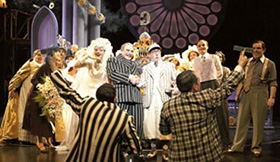 There had been very few plays about Hollywood—and even fewer satires—when the 24-year-old Moss Hart approached George S. Kaufman in 1929 with a first draft called Once in a Lifetime. Kaufman leapt at the chance to collaborate with the first-time writer and, although neither man had been to Hollywood, they had been inundated with enough fatuous material in the press and with enough dopey movies to take a crack at satirizing the film colony. Their gifts for poking Hollywood in its collective eye were so sharp that, 75 years later, Once in a Lifetime remains the granddaddy of all Tinseltown comedies (Singin’ in the Rain borrows heavily from it) and is arguably still the best. Certainly as a gag-filled, glamorous, dynamic portrait of the idiocies of the film industry at its peak, this comedy cannot be topped.
There had been very few plays about Hollywood—and even fewer satires—when the 24-year-old Moss Hart approached George S. Kaufman in 1929 with a first draft called Once in a Lifetime. Kaufman leapt at the chance to collaborate with the first-time writer and, although neither man had been to Hollywood, they had been inundated with enough fatuous material in the press and with enough dopey movies to take a crack at satirizing the film colony. Their gifts for poking Hollywood in its collective eye were so sharp that, 75 years later, Once in a Lifetime remains the granddaddy of all Tinseltown comedies (Singin’ in the Rain borrows heavily from it) and is arguably still the best. Certainly as a gag-filled, glamorous, dynamic portrait of the idiocies of the film industry at its peak, this comedy cannot be topped.
The road to Broadway was not an easy one, however, as Hart chronicled brilliantly in his 1959 memoir, Act One. Kaufman not only cowrote the script, but directed it as well and played the supporting part of the cynical and despairing East Coast playwright, Lawrence Vail. During the play’s tryouts, Kaufman thought the show was a lost cause, but Hart prevailed and they roared into the Music Box Theater with a huge hit. The play’s success made Hart’s reputation (he would go on to play Vail in a Los Angeles production) and the partnership of Kaufman and Hart was off to a resounding start. In a gesture not often seen in the frequently ungenerous world of the theater, George Kaufman announced at the opening night curtain call that “80% of this show is Moss Hart.”
Stage history
Once in a Lifetime opened at the Music Box Theatre on September 24, 1930 and ran for 305 performances. It was eventually filmed in 1932, although industry wags wondered how any film producer would have the guts to put it on screen. (Universal producer Carl Laemmle affixed his signature to a title card saying the industry had “the ability to laugh at itself.”)
The show’s immense size kept it off the boards for many years (although an intriguing item in Variety in 1954 claimed that Hart was going to rewrite it as a musical spoof of 3-D for Phil Silvers), until the Royal Shakespeare Company produced a smash revival in 1977 with Zoe Wanamaker and Richard Griffiths.
A 1978 Broadway revival at Circle in the Square, starring John Lithgow and Treat Williams restored the show’s reputation in the States and many repertory theaters have produced it since, including the Guthrie Theatre in Minneapolis in 2001, with Richard Kind as George and Lewis J. Stadlen as Glogauer. In the winter of 2005, London’s National Theatre produced a first-class revival with David Suchet as Gloguaer.
Other Plays in the Catalogue
By George S. Kaufman and Morrie Ryskind. Music and Lyrics by Bert Kalmar and Harry Ruby. Cast size: 16 men, 10 women. Animal Crackers opened on October 23, 1928 at the 44th Street Theater, and it ran 191 performances.
Silk Stockings' producers, Cy Feuer and Ernest Martin, had a success with Guys and Dolls in 1950. Attempting to work again with Kaufman, who directed that production, they ultimately balked at the romantic aspect of Kaufman's adaptation of the film, which he wrote with his second wife, Leueen MacGrath.
By Moss Hart and George S. Kaufman. Cast size: 20 men, 19 women, plus extras; 5 sets. Once in a Lifetime opened at the Music Box Theatre on September 24, 1930 and ran for 305 performances.
Table of Contents
Contact Us Today
Interested in bringing George S. Kaufman’s timeless plays to your stage?
Please refer to the contact information for each specific play on the various collection pages for direct amateur and professional licensing information.
Plays are represented by Concord Theatricals, Broadway Dramatic Licensing, and Music Theatre International respectively
If you are interested in first-class performance or film/television rights:
In the US, George S. Kaufman’s plays are represented by:
CPK Artists, LLC
In the UK, George S. Kaufman’s plays are represented by:
Alan Brodie Representation
For more information about George S. Kaufman or this website, contact:
Laurence Maslon
Literary Trustee, George S. Kaufman Estate


